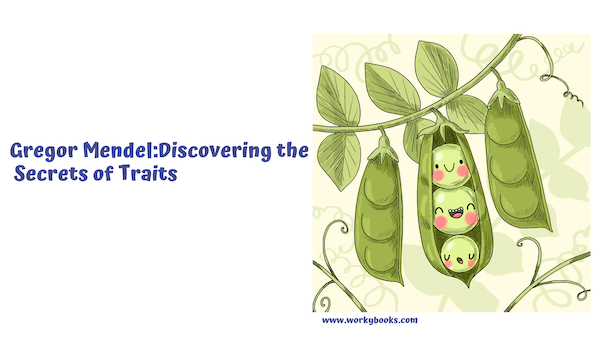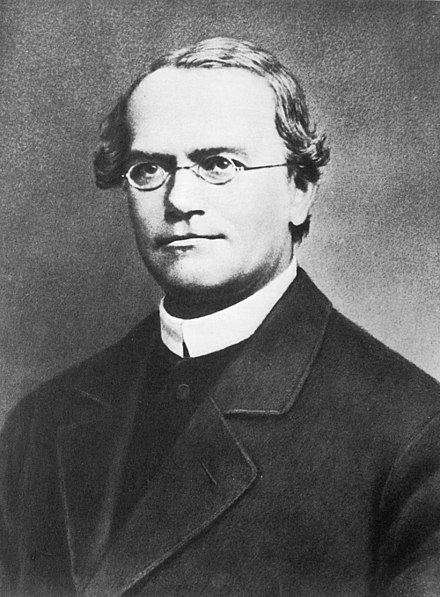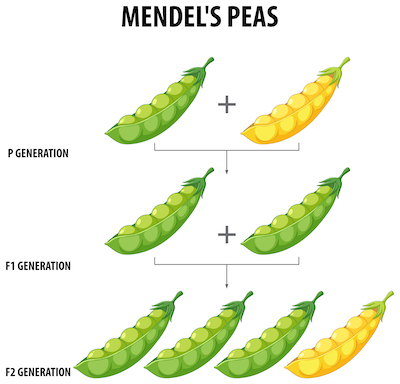Gregor Mendel: Discovery of Traits

Gregor Mendel was a pioneer who discovered the basic principles of heredity through his work with pea plants. His principles of dominance, segregation, and independent assortment explain how traits are inherited from parents to offspring. Mendel’s discoveries have had a lasting impact on science, helping us understand genetics and the inheritance of traits in all living things.
Who was Gregor Mendel?
Gregor Mendel lived, over 150 years ago. Gregor Mendel was a kind and curious man who lived in a monastery, which is a quiet place where monks live and work. He was born in a small village in Austria in 1822. From a young age, Mendel loved learning about plants and nature. As he grew up, he became a monk and spent a lot of time studying the world around him.

What did Gregor Mendel study?
Gregor Mendel loved gardening, and he was especially interested in pea plants. Pea plants are great for studying because they grow quickly, and they have many different traits, like flower color and seed shape. Mendel wanted to understand how these traits were passed from one generation of pea plants to the next. So, he began a series of experiments that would take him many years to complete.

What did Gregor Mendel discover?
Through his careful experiments, Mendel discovered three important principles that help explain how traits are inherited. These principles are still important today and form the foundation of genetics, the science of heredity.
Mendel’s experiments on pea plants
To find out how traits are passed from parents to offspring, Mendel performed experiments with pea plants in the monastery garden. He focused on specific traits like:
- Flower color: Purple or white
- Seed shape: Round or wrinkled
- Pod color: Green or yellow
Mendel carefully controlled the way pea plants pollinated, which means he decided which plants would breed with each other. This way, he could observe how traits appeared in the next generation of plants. He used two types of pea plants for his experiments:
- Purebred plants: These plants always produced offspring with the same traits as the parent. For example, a purebred purple flower plant always produced purple flowers.
- Hybrid plants: These plants were the result of crossing two purebred plants with different traits, like a purple flower plant with a white flower plant.

By crossing these plants and observing the results, Mendel made some amazing discoveries.
Mendel’s Three Principles of Inheritance
- The Principle of Dominance-Mendel noticed that when he crossed a purebred purple flower plant with a purebred white flower plant, all the offspring had purple flowers. He called the purple trait “dominant” because it seemed to cover up the white trait.
- The Principle of Segregation-When Mendel allowed the hybrid plants to pollinate themselves, he found that the white flower trait reappeared in the second generation of plants. This happened because each plant has two factors (we call them genes today) for each trait, one from each parent. These factors separate, or segregate, during the formation of the reproductive cells, so each new plant gets one factor from each parent.
- The Principle of Independent Assortment-Mendel also studied how different traits were passed on at the same time. He found that the inheritance of one trait (like flower color) did not affect the inheritance of another trait (like seed shape). This principle of independent assortment means that different traits are passed down independently of each other.
How did Mendel’s discoveries help us understand genetic traits better?
Before Mendel’s work, people didn’t really understand how traits were passed from parents to offspring. Some thought it was like mixing paint, where the traits blended together. But Mendel’s experiments showed that traits are inherited in specific patterns, not just mixed together randomly.
Thanks to Mendel, we now understand that:
- Traits are passed down in predictable ways: We can often predict what traits an offspring will have based on the traits of the parents.
- Genes come in pairs: Each parent contributes one gene for each trait, and these genes can be dominant or recessive.
- Traits are inherited independently: Different traits are passed down separately from each other.
Mendel’s discoveries laid the groundwork for modern genetics, helping scientists understand how traits are passed down in humans, animals, and plants. For example, we now know that many human traits, like eye color and blood type, follow the same patterns that Mendel observed in pea plants.
Fun facts about Gregor Mendel
- Mendel’s work wasn’t recognized during his lifetime. It wasn’t until the early 1900s, long after his death, that scientists rediscovered his research and realized how important it was.
- Mendel was not only a scientist but also a teacher and a beekeeper. He loved learning and teaching others about the natural world.
- Even though Mendel worked with pea plants, his principles apply to all living things, including animals and humans.
Click here for worksheets on pumpkin life cyclel!



